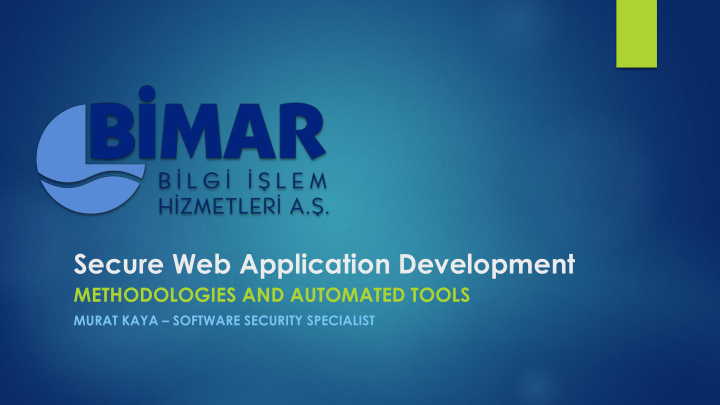



Secure Web Application Development METHODOLOGIES AND AUTOMATED TOOLS MURAT KAYA – SOFTWARE SECURITY SPECIALIST
Agenda Software Security Overview Software Security Methodologies Security Test Methods Analysis Tools Tools Auditing Samples Preparing Analysis Results Sample Analysis Results Managing of Findings and Vulnerabilities Q&A
Software Security Overview Security is a " risk management " with the most basic expression. Secure software refers to that has been designed from the ground up with all security processes, enhanced with security checks, and completed with security tests. Software security is based on internationally accepted methods. It's not a one-time process In reality there is no %100 secured software
Software Security Overview
Methodologies OpenSAMM (Software Assurance Maturity Model) SAMM is an open framework to help organizations formulate and implement a strategy for software security that is tailored to the specific risks facing the organization As an open project, SAMM content shall always remain vendor-neutral and freely available for all to use SAMM was defined with flexibility in mind such that it can be utilized by small, medium, and large organizations using any style of development. SDL (Secure Development Lifecycle) SDL is a software development process that helps developers build more secure software and address security compliance requirements while reducing development cost Developed by Microsoft Security Technology Unit. The ability of an application to be included in the SDL process depends on the use of the application. If an application needs Internet access, it will be included in a process that can contain important information.
Methodologies - OpenSAMM The resources provided by SAMM will aid in: Evaluating an organization’s existing software security practices Building a balanced software security program in well-defined iterations Demonstrating concrete improvements to a security assurance program Defining and measuring security-related activities within an organization
Methodologies - OpenSAMM Business Functions Governance Construction Verification Deployment STRATEGY ENVIROMENT EDUCATION SECURITY DESIGN OPERATIONAL SECURE SECURITY & METRICS HARDENING & GUIDANCE REQUIREMENTS REVIEW ENABLEMENT ARCHITECTURE TESTING POLICY ISSUE THREAT IMPLEMENT & COMPLIANCE MANAGEMENT ASSESSMENT REVIEW
Methodologies – SDL The resources provided by SDL will aid in: The SDL Helps you build software that's more secure by reducing the number and severity of vulnerabilities in your code Incorporating the SDL into the application development process helps meet compliance requirements and produce a return on investment (ROI) by guiding organizations to make smart choices early in the design process, thereby minimizing expensive inefficiencies. The SDL systematically addresses software security during the development phase, ensuring that vulnerabilities are more likely to be found and fixed prior to application deployment and thereby reducing your total cost of software development.
Methodologies – SDL Education Process Accountability Incident Administer and track Guide product teams to Establish release criteria Response security training meet SDL requirements and sign-off as part of FSR (MSRC) Ongoing Process Improvements
Security Test Methods Static Code Analysis (Source Code Analysis) Static Code Analysis (also known as Source Code Analysis) is usually performed as part of a Code Review (also known as white-box testing) and is carried out at the Implementation phase of a Security Development Lifecycle (SDL) Penetration testing options include black box, white box and gray box tests. White box , or authenticated tests, target the security of your underlying technology with full knowledge of your IT department. Black box , or unauthenticated, tests closely represent a hacker attempting to gain unauthorized access to a system or IT infrastructure to obtain and exfiltrate data. Gray box testing lies between black and white. Testers will have knowledge of some areas but not others.
Analysis Tools Static Code Analysis Tools SonarQube HPE Fortify SCA Telerik Platforms Pentration Testing Tools Accunetix Web Vulnerability Scanner HPE WebInspect OWASP Zap Proxy SoapUI, Burp e.t.c Fuzzing Tools
Auditing – Fortify SCA Visual Studio
Auditing – Fortify SCA Workbench
Auditing – Fortify SSC Portal
Auditing – Fortify SSC Portal
Auditing – SonarQube
Auditing – SonarQube
Auditing – HPE WebInspect
Auditing – Acunetix WVS
Preparing Analysis Results All findings that obtained from automated tools or manual analyzes are reviewed by security auditor before assigning to developer. False positives. Unrelated codes etc. Reports are generated with below main headings; Security Level Owasp Category Type of Evidence Effect of Evidence Complete Analysis of Steps Base Solutions The report that prepared with above details are sent to team and technical leaders after encrypted with PGP
Sample Analysis Results - Executive
Sample Analysis Results - Annual
Sample Analysis Results - Developer
Managing Vulnerabilities TFS ( Team Foundation Server ) Just « critical » vulnerabilities Automatically opened « Bug » type workitems «High» priority HPE Fortify SSC (Software Security Center) All vulnerabilities with categorized dashboards All kind of reports can be generated Historically scan results and metrics Automatic/Manual assigment to team members
Q & A ?
Recommend
More recommend